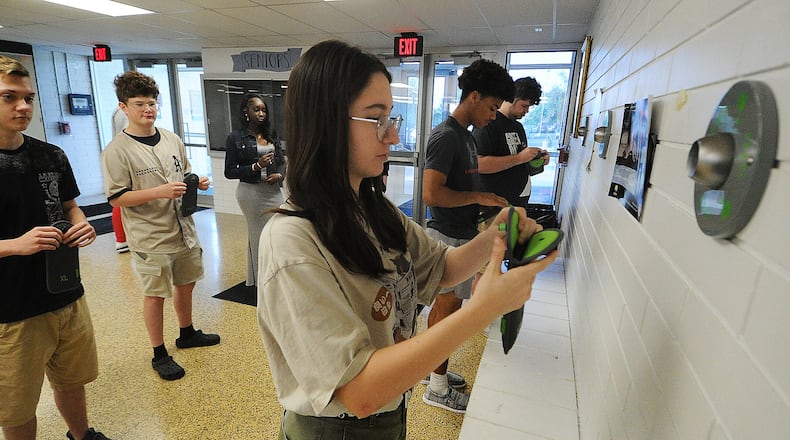“Our schoolchildren currently face countless distractions every day from the devices in their pockets,” DeWine said when signing the new law. “By limiting these distractions, we will reestablish the opportunity for students across Ohio to immerse themselves in their classwork, learn from their teachers, and create lifelong memories with their closest friends.”
A Journal-News review of Butler County schools finds many already have policies addressing that goal, though some local school officials say they plan to use the new state guidelines to further fine-tune their rules.
Over the years, cell phone policies have been altered by individual districts to combat not only general distractions during class times, but also to minimize social media bullying, facilitate better learning through controlled use in some classroom instruction and enhance school security through alerts.
In Lakota Schools, the largest in the county, district officials are planning to get parent input before incorporating any cell phone policy changes.
“Lakota’s personal communication device policy, which includes cell phones, has been in place for several years,” said Betsy Fuller, spokeswoman for Lakota..
“The board of education is planning to gather input regarding what policy updates might be needed to best help our students thrive academically, socially and emotionally. In September, Lakota staff, students, parents and guardians will be invited to participate in an (online) survey and a community conversation about this policy,” said Fuller.
Edgewood Schools Superintendent Kelly Spivey said her district has already acted by adopting the new law’s cell phone policy.
“Although the deadline for implementation is July 2025, we wanted to implement it this year,” said Spivey.
“It is too early to know about the effects because we have only been in school a few days. However, the informal feedback has been extremely positive. Many of our students are saying that it isn’t as stressful, while others are saying they wish they could still listen to music.”
Hamilton Schools’ Andrea Blevins, associate superintendent who will take over the top job next school year, said the district’s current policy was adopted in 2019 and will be changed according to the new law.
“Our current policy was written to minimize distractions caused by cell phones while still allowing for student/staff autonomy to enhance learning or during non-academic aspects of the school day,” said Blevins.
“The Hamilton City School Board of Education will work together with (an Ohio policy consultant firm) this fall to review our current policy and the effectiveness of our policy in its current state. We will, then, make any necessary revisions to this policy, if needed.”
Fairfield Assistant Superintendent Kim Hauer said “our current policy on the use of electronic communications equipment by students reflects our discretion to manage cell phone usage to maintain focus on education.”
“However, in light of the recent enactment of (new law), we will be reviewing our policy to ensure full compliance with the new legislation,” said Hauer.
Monroe school officials said their current policy is already in compliance.
“Our district policy on personal communication devices was last revised in 2017,” said Monroe Schools spokesman Adam Marcum, “District leadership reviewed (the new law) — as well as the model policy shared by the state — earlier this year and it was determined that Monroe’s existing policy meets or exceeds all necessary requirements.”
Officials at Middletown Schools did not respond to a request for comment but instead shared the district’s existing policy, which states: “Students are expected to focus on academics when they are at school. A technology violation is defined as when a student engages in non-serious or inappropriate (as defined by school) use of cell phone, pager, music/video players, camera, tablet and/or computer.”
In Talawanda Schools students have not been permitted to have mobile phones out during class,” said district Spokeswoman Holli Hansel.
The new law will have little if any impact on Talawanda policy, she said.
“Not much has changed. Students are asked to keep their phones put away, and some teachers have a location for students to place their phones during class, and then the students can pick them up.”
“I am aware that some students just keep them in their lockers or school backpack throughout the school day, but then have access to use it for a communication need they may have after school hours. Students and parents know this and have been informed this year and in previous years,” said Hansel.
The new law, which must be adopted by Ohio schools by July 2025, requires all districts to place an emphasis on limiting cell phone use and reducing cell phone-related distractions in classrooms. It also includes exceptions for students who require a cell phone to monitor a health concern or for student learning as determined by school officials.
“Local school districts will create the policies that work best in their environments and for their students, but the core mission of this bill is clear: minimize screen time during school time,” said DeWine. “Not only is this time precious for the educational development of our children, but we also have a responsibility to safeguard our kids from the nonstop barrage of alerts from the internet and social media that have been proven to be damaging to their mental health.”
About the Author

